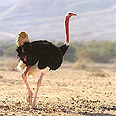
Back into the wild
Nature inspectors released 13 ostriches back into the wild in a bid to return the bird to its natural habitat
Nature Authority inspectors released 13 ostriches back into the wild Wednesday in a first-of-its-kind experiment to return the world's biggest bird back to its natural habitat.
The project's supervisor Professor David Zeltz told Ynet that he and his colleagues have doubts regarding the project's success.
"Perhaps over the next three years the number of ostriches will reach 1,000, and perhaps there will be none," he said.
It took the flock an hour and a half to leave its Arava cage, said the reservation manager who was sent to tour the area after gates were unlocked.
Zeltz said the purpose of the manager's tour was to see whether the birds were keeping their distance from him.
"Had they not stayed away from him, we would have taken them back to the reservation," the professor said.
The ostriches will now have to fend for themselves. The area is rich inacacias, the ostrich's main source of food. However, Authority officials said they will supply the birds with drinking water via a permanent water trough.
The right time
Eilat District Nature and Park Authority manager Guy Alon said he believes the ostriches will survive.
"In order to reintroduce an animal into the wild, one has to make sure the elements that brought about its extinction have disappeared," he said.
Alon said most Ostriches died as a result of hunting, which no longer exist in the area.
"Conditions are ripe to release the ostriches," he said.
However, professionals fear hikers may attempt to feed the birds, which creates dependency between the animal and humans and may cause the ostriches to become aggressive once its demands for food are refused.










